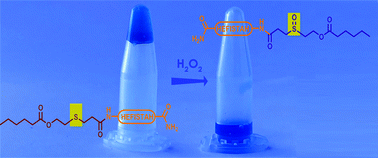Synthesis and characterization of mono S-lipidated peptide hydrogels: a platform for the preparation of reactive oxygen species responsive materials†
Abstract
In this work we report the synthesis of mono lipidated peptides containing a 3-mercaptopropionate linker in the N-terminus by means of a photoinitiated thiol–ene reaction (S-lipidation). We evaluate the self-assembling and hydrogelation properties of a library of mono S-lipidated peptides containing lipid chains of various lengths and demonstrate that hydrogelation was driven by a balance between the lipid chain's hydrophobicity and the peptide's facial hydrophobicity. We further postulate that a simple calculation using estimated values of log D could be used as a predictor of hydrogelation when designing similar systems. A mono S-lipidated peptide containing a short lipid chain that formed hydrogels was fully characterized and a mechanism for the peptide hydrogelation developed. Finally, we demonstrate that the presence of the thioether group in the mono S-lipidated peptide hydrogels, which is a feature lacking in conventional N-acyl lipidated systems, enables the controlled disassembly of the gel via oxidation to the sulfoxide by reactive oxygen species in accordance with a hydrophobicity-modulated strategy. Thus, we conclude that mono S-lipidated peptide hydrogels constitute a novel and simple tool for the development of tissue engineering and targeted drug delivery applications of diseases with overexpression of reactive oxygen species (e.g. degenerative and metabolic diseases, and cancers).

- This article is part of the themed collection: Chemical Biology in OBC


 Please wait while we load your content...
Please wait while we load your content...